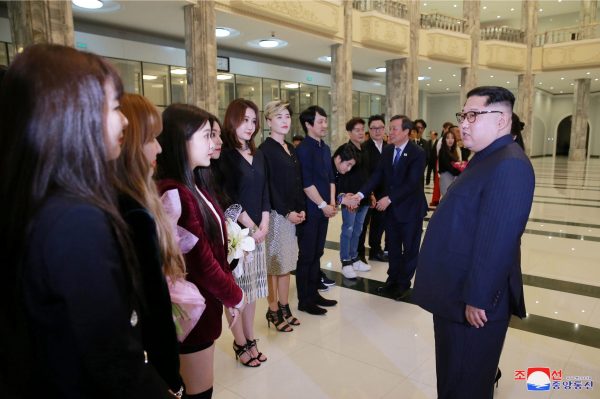Between 25 and 28 March, Kim Jong-un made his first foreign trip since taking power in 2011 for a meeting with Chinese President Xi Jinping in Beijing. On 27 April Kim is scheduled to meet with South Korean President Moon Jae-in in Panmunjom, the joint security area within the demilitarized zone that splits the two Koreas, for the third ever inter-Korean summit. This is to be followed by a summit between Kim and Trump before the end of May — the first ever meeting between a North Korean leader and a sitting US president. What are North Korea’s intentions?
Those recommending caution over summit diplomacy have warned that North Korea seeks recognition of its status as a nuclear power, to divide the US–ROK alliance and US–China cooperation to gain sanctions relief and to use the summits to buy more time while ultimately intending to unify the Korean Peninsula on its own terms.
Yet these arguments fail to recognise the fundamental weakness of North Korea’s position. North Korea’s conventional weaponry consists of rusty Soviet technology maintained through creative means out of a desperate lack of resources. While North Korea can lob missiles capable of inflicting massive damage at Seoul and Tokyo to deter regime change by force, it would clearly lose any full-scale war. Kim Jong-un knows that any use of his nuclear stockpile would be to sign his own death warrant. North Korea’s pursuit of the nuclear option is best described as a last-gasp insurance wild card.
The gap in GDP per capita between the North and South is the largest of that between any two countries in the world that share a border. Sanctions have further put the squeeze on the impoverished North Korean economy, especially with the active participation of China since mid-2017. North Korea overwhelming lost the battle for hearts and minds long ago in the eyes of the international community, and it relies on a combination of relentless propaganda and a brutal system of coercion and repression to maintain legitimacy among its own citizens.
In Kim Jong-un’s meeting with South Korean national security chief Chung Eui-yong and intelligence chief Suh Hoon and during his summit with Chinese President Xi Jinping, the North Korean leader expressed his willingness to denuclearise with the caveat that the security of the North Korean regime be guaranteed. This brings the negotiations back to where they were over a decade ago when the Six Party Talks agreed on the September 2005 joint statement which aimed at realising a comprehensive resolution on the North Korean problem. The big difference now is that North Korea’s nuclear capabilities are no longer theoretical.
Under a comprehensive agreement North Korea would denuclearise in exchange for the conversion of the Korean War armistice agreement into a permanent peace treaty, the normalisation of North Korea’s diplomatic relations with the United States and Japan, and the provision of large-scale economic cooperation. North Korea would be assured its post-denuclearisation survival in both military and economic terms.
What needs to be done to realise the opportunity the upcoming summits present without falling into past traps? Can a lasting agreement be reached to overcome the intractable geopolitical challenge that the Korean peninsula has presented ever since its partition over seven decades ago?
One reason past efforts tripped up was due to the failure to agree on how to sequence implementation of an agreement containing these elements. While all parties agreed on the framework, there was no agreement on the roadmap towards their implementation. The absolute lack of trust on both sides requires an intricately detailed roadmap of step-for-step actions and verification procedures that navigate both sides from the current stalemate to a future where North Korea is both denuclearised and its regime security has a durable iron-clad guarantee.
A new challenge this time round is the lack of diplomatic and strategic leadership from the United States. The lack of any political convictions or ideology that guides US President Trump’s policy agenda opened the way for a potential Trump–Kim summit against decades of precedent of the United States’ refusing such a meeting. But Trump’s rapid turnaround, along with his fulminations over the Iran deal and the recent announcements that known North Korea hawks John Bolton and Mike Pompeo will join the administration, casts doubt on US commitment to follow through on any future agreement.
The most vital ingredient to solving this geopolitical conundrum is South Korean leadership. As David Kang explains in our lead essay this week, ‘[t]he upcoming summit between South Korean President Moon Jae-in and North Korean leader Kim Jong-un will be more important than any meeting between Kim and US President Donald Trump that may follow’. If the Moon–Kim summit goes poorly there may not even be a Trump–Kim summit. Equally, the Moon–Kim summit has the potential to set the contours and substance for a Trump–Kim summit. This is because it will serve as a road test for ‘a set of possible negotiating points that could come up between Trump and Kim. This would provide both the United States and North Korea some indication of what is possible if the two sides ever meet’.
The ‘tangible improvement in relations between North and South Korea’ shows some promising signs. ‘The hotline between South and North Korea has been re-opened at Panmunjom, and Moon and Kim are establishing a hotline between the two leaders themselves … Kim has pledged a moratorium on missile testing, even during the US–South Korea military exercises planned for April 2018’.
The stage is set for Moon and Kim to deliver something of substance. As Kang concludes, ‘the key question is whether they are able to conduct their diplomacy at this level’. If they are up to the task the impossible dream of a sustainable peace on the Korean peninsula may yet be within grasp.
The EAF Editorial Board is located in the Crawford School of Public Policy, College of Asia and the Pacific, The Australian National University.

